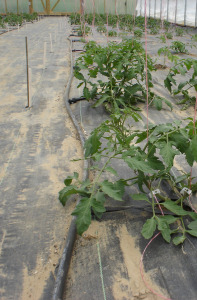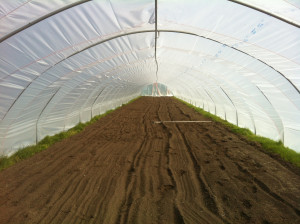Some important factors that should be considered in your site selection:
Light
- Good sunlight is needed, especially early in the season
-
Calculating the angle of incidence (angle between the sun’s rays and line perpendicular to the surface at the point of incidence) at different latitudes is prudent for winter production
- Angles of incidence from 0° to 50° have minimal effect on light transmittance
- As the angle of incidence increases above 50°, light transmittance decreases rapidly
- For example, when the angle of incidence changes from 0° to 90° in 10° increments, the respective transmittance of light through 3mm glass is 0.86, 0.86, 0.86, 0.85, 0.77, 0.65, 0.40, and 0
-
- Avoid shadows cast from trees, adjacent high tunnels or other buildings
- Trees and structures on all sides of the high tunnel should ideally be set back 2.5 times their height
- As a rule of thumb, multiple single bay high tunnels in an east-west orientation should be 20’ apart
- As a rule of thumb, multiple single bay high tunnels in a north-south orientation can be as close as 4′ apart
- Locating high tunnels north of major structures is an undesirable siting
Windbreaks
-

Photo by: www.centerforagroforestry.org
Trees, shrubs, and fabricated material like wood lath can be used as a barrier to moderate and/or redirect wind
- Air pressure builds up on the side toward the wind (windward side) and air moves over the top and around the ends of the barrier
- Windbreaks could consist of woody shrubs designed to be harvested for fruit or flowers
- Four characteristics of a windbreak affect the area protected by it: Height, Density, Orientation, and Length
- The interaction between height and densityof the windbreak determines the degree of 1) wind speed reduction, and 2) downwind area protected
- Heightof the windbreak is the most important factor in determining the amount of area protected downwind
- Wind speed reductions are measured on the side toward the wind (windward side) for a distance of 2 to 5 times the height of the windbreak
- Wind speed reductions are measured on the side away from the wind (leeward side) for a distance
Click here to download the paper about Windbreak Management
up to 30 times the height of the windbreak
- Densityof the windbreak is defined as the ratio of solid matter in the barrier to total area of the barrier
- Windbreak density of about 50% is rule of thumb for best wind speed reduction
- Very dense windbreaks result in low pressure developing on their leeward side which pulls downward air coming over their top, creating turbulence and reducing protection downwind
- Less Dense windbreaks allow more air to flow through them which moderates the build up of low pressure and turbulence to increase protection downwind; however wind speed reductions are not as great
- Density of windbreaks consisting of deciduous trees is about 25-35%, of conifers about 40-60% , and of multi-row conifers about 60-80%
- Windbreak density of about 50% is rule of thumb for best wind speed reduction
- Orientation of windbreaks should be at right angles to prevailing winds that occur during the most critical periods of the production season
- Examples of a critical periods are cold winter winds carrying snow or during the spring or summer when ventilation is required and strong prevailing winds may damage plants near the sides of the high tunnels
- Windbreaks on the north side of a high tunnel should be about 100 feet away to keep snow drifts back from the structures
- Lengthof a windbreak determines the total area receiving protection
- Length of a windbreak should be 10 times longer than it is high which reduces the occurrence of end-turbulence
- Gaps in the length of windbreaks decrease their effectiveness by creating funnels or lanes that concentrate wind
- Heightof the windbreak is the most important factor in determining the amount of area protected downwind
Water Supply
 Irrigation source is required because crops will not receive moisture from rainfall
Irrigation source is required because crops will not receive moisture from rainfall- Adequate water quantity is necessary
- Two quarts of water can easily be applied to one square foot in a single application
- Good water quality is essential for successful production
- Well water is often desired; however, it may be high in alkalinity which can lead to clogged drip irrigation lines and high pH problems
- Municipal or rural water is often cost prohibitive and may contain undesirable additives like Fluoride
- Pond or river water may contain disease organisms and may require filtration to remove silt and other particulate matter that might clog irrigation systems
- Methods of irrigation depend on goals of production
- Drip irrigation reduces foliar diseases
- Overhead irrigation increases cooling effects
- If soluble fertilizer will be injected through irrigation lines, consider compatibility of water supply, delivery system and fertilizer injector
- Protect water supply line and hydrant from freezing in winter by burying below frost line, or by installing drains
Soil Topography
 Though it may be tempting to select an unproductive field site for the high tunnel, good soil quality is important
Though it may be tempting to select an unproductive field site for the high tunnel, good soil quality is important- Soilshouldbewell drained
- Good drainage improves quality of the plants
- Problems with water logging and flooding are avoided
- Soil warming is improved
- Amend soil with compost, peat, or other organic materials to improve drainage and quality
- The high tunnel is most productive if built on a slightly elevated pad that is three feet larger than the structure in all directions
- Level interior of the high tunnel with a slight slope to the exterior
- The pad should be high enough to prevent water from flowing into the high tunnel from a rainfall or melted snow, especially if the structure is built in a low-lying area
Accessibility
- High tunnel location should be accessible by well maintained roads and convenient to the grower because daily maintenance is often necessary
- High tunnel structure should be convenient to water source, tool storage, cooler, packing shed and possibly electrical and/or fuel source to facilitate labor efficiency





